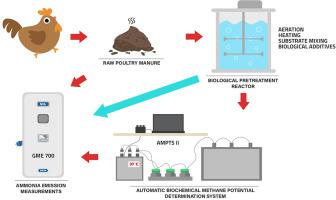Biomass & Bioenergy ( IF 5.8 ) Pub Date : 2020-10-12 , DOI: 10.1016/j.biombioe.2020.105815 Mantas Rubežius , Rolandas Bleizgys , Kęstutis Venslauskas , Kęstutis Navickas

|
Poultry manure has great potential for renewable energy utilization in biogas production. However, extremely high levels of nitrogen lead to unstable conditions in the anaerobic process, including the accumulation of intermediates, such as ammonia, which reduces the biogas production and the quality of the biogas. For this reason, additional measures are needed to ensure the proper management of poultry manure in anaerobic systems. This study evaluated the effect of primary biological treatment of poultry manure on biochemical methane potential (CH4) and reduction of ammonia (NH3) emissions. The results obtained when evaluating the biochemical methane potential from the digestate revealed that the biological additives selected for the study did not significantly influence the biochemical methane potential. After considering the differences of dry organic matter, it was found that maintaining optimum conditions and using biological additives during pretreatment increases the biochemical methane potential from 11.00 to 89.94 L CH4/kg volatile solids (VS). Biological pretreatment of poultry manure has a positive effect on biogas composition: methane concentration increases by 6.3–10.4% after pretreatment, and impurities such as hydrogen sulphide (H2S) decrease by 1.1–17.4 times. Ammonia emissions from all treatments of poultry manure were higher than those from untreated poultry manure, as measured by the evaporation rate of NH3. However, when measuring the evaporation rate of NH3 from the digestate, it was found that NH3 emission rates showed similar trends.
中文翻译:

家禽粪便的生物预处理对生化甲烷潜力和氨排放的影响
家禽粪便在沼气生产中具有可再生能源利用的巨大潜力。然而,极高的氮含量导致厌氧过程中的不稳定条件,包括诸如氨之类的中间体的积累,这降低了沼气的产生和沼气的质量。因此,需要采取其他措施来确保在厌氧系统中正确处理家禽粪便。本研究评估了家禽粪便的一次生物处理对生化甲烷潜力(CH 4)和氨氮(NH 3)还原的影响)排放。评估消化液中的生化甲烷潜力时获得的结果表明,选择用于研究的生物添加剂不会显着影响生化甲烷潜力。考虑到干燥有机物的差异后,发现在预处理过程中保持最佳条件并使用生物添加剂可使生化甲烷潜力从11.00升高至89.94 L CH 4 / kg挥发性固体(VS)。家禽粪便的生物预处理对沼气成分具有积极影响:预处理后甲烷浓度增加6.3–10.4%,以及诸如硫化氢(H 2S)减少1.1–17.4倍。以NH 3的蒸发速率来衡量,所有处理的家禽粪便中的氨排放均高于未处理的家禽粪便中的氨排放。然而,当测量消化物中NH 3的蒸发速率时,发现NH 3排放速率显示出相似的趋势。











































 京公网安备 11010802027423号
京公网安备 11010802027423号